Students get through AP Inter 1st Year Physics Important Questions 8th Lesson Oscillations which are most likely to be asked in the exam.
AP Inter 1st Year Physics Important Questions 8th Lesson Oscillations
Very Short Answer Questions
Question 1.
Give two examples of periodic motion which are not oscillatory.
Answer:
The revolution of Planets around the Sun is Periodic, but it is not Oscillatory.
Similarly, the revolution of Electrons around the Nucleus is Periodic, but it is not Oscillatory.
Question 2.
The displacement in S.H.M is given by y=Asin(20t+4). What is the displacement when it is increased by 2π/ω? [Imp. Q]
Answer:
Given y = Asin(20t + 4)
\(\frac{2 \pi}{\omega}\)
So when time is increased by one time period, the body will have the same displacement,
i. e., y = A sin (20t+4)
Question 3.
A girl is swinging seated in a swing. What is the effect on the frequency of oscillation if she stands? [Imp.Q]
Answer:
The effective length of the swing decreases due to rise in the position of centre of mass.
Since T ∝ √l, Time period decreases, so frequency increases.
Question 4.
The bob of a simple pendulum is a hollow sphere filled with w ater. How w ill the period of oscillation change, if the water begins to drain out of the hollow sphere?
Answer:
As water begins to drainout from the hollow sphere, the centre of mass of (sphere + water) system goes down. So the effective length of pendulum increases. As T ∝ √l, the time period (T) also increases.
When water is completely drained out the centre of mass comes to its original position (i.e., centre of the sphere). So the pendulum will have its original time period.
Question 5.
The bob of a simple pendulum is made of wood. What will be the effect on the time period if the wooden bob is replaced by an identical bob of aluminum?
Answer:
The time period of a simple pendulum does not depend upon the size, shape or material of the bob as long as its length is kept constant. So if the wooden bob is replaced by identical aluminium bob, there will be no change in its time period
![]()
Question 6.
Will a pendulum clock gain or lose time when taken to the top of a mountain? [Imp. Q]
Answer:
The time period of a pendulum is T = 2π\(\sqrt{\frac{l}{g}}\)
When a pendulum clock is taken to the top of the mountain, its time period increases, because as we go upwards from the surface of earth the value of g decreases. As time period increases, it will take more time to complete one oscillation, so the pendulum clock loses time. Hence, it will go slow.
Question 7.
A pendulum clock gives correct time at the equator. Will it gain or lose time if it is taken to the poles? If so, why? [Imp. Q]
Answer:
At poles the value of ‘g’ is more.
The relation between time period (T) and g is T = 2π\(\sqrt{\frac{l}{g}}\)
So as ‘g’ increases. T decreases. As time period (T) decreases it will make more oscillations. So the clock gains time.
Question 8.
What fraction of flic total energy is K.E when the displacement is one-half of amplitude of a particle executing S.H.M?
Answer:

So, K.E is 3/4 of T.E when displacement is half of amplitude.
Question 9.
What happens to the energy of a simple harmonic oscillator if its amplitude is doubled? [Imp .Q]
Answer:
Total energy of a simple harmonic oscillator is
T.E = \(\frac{1}{2}\)mω²A²
where m = mass of the particle; ω = angular velocity; A = amplitude
When amplitude is doubled, the new T.E will be
T.E = \(\frac{1}{2}\)mω² (2A)² ⇒ 4 × mω²A² = 4 × initial T.E
So total energy will be increased to 4 times.
![]()
Question 10.
Can a simple pendulum lie used in an artificial satellite?
Answer:
Inside an artificial satellite, the effective value of g is zero.
The time period of the simple pendulum is given by T = 2π\(\sqrt{\frac{l}{g}}\)
As g = 0, T = ∞. Thus, inside a satellite, the pendulum does not oscillate. So a simple pendulum cannot be used in an artificial satellite.
Short Answer Questions
Question 1.
Define simple harmonic motion? Give two examples. [Imp.Q]
Answer:
Simple Harmonic Motion :
The ‘to and fro motion’ of a particle along a straight line, about a fixed point is said to be “Simple Harmonic”, when the direction of its acceleration is always towards that fixed point and the magnitude of the acceleration is proportional to its displacement from that fixed point.

Thus, acceleration ∝-displacement
⇒ a ∝ – x
⇒ a = -kx, Here k is the Proportionality constant.
The negative sign indicates that acceleration and displacement are opposite in direction.
Ex : Motion of a loaded spring which is stretched and released, vibrations of the prongs of a tuning fork, the oscillations of a simple pendulum with small displacement
Question 2.
Present graphically the variations of displacement, velocity and acceleration with time for a particle in S.H.M.
Answer:
The graphical presentation of the variations of (a) displacement (b) velocity (c) acceleration with time for a particle in S.H.M is as follows:
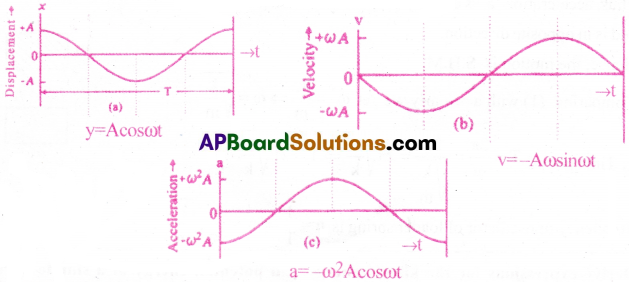
Question 3.
What is phase? Discuss the phase relations between displacement, velocity and acceleration in simple harmonic motion.
Answer:
Phase of a particle at any instant represents its position and direction of motion.
In the equation, y=Asin(ωt + θ), where (ωt + θ) gives the phase of the particle.
At time t = 0, if the particle is at mean position, then θ = 0.
Suppose the displacement of a particle executing S.H.M is given as y = Asinωt
Then its velocity will be equal to

So there will be a phase difference of π/2 between displacement and velocity.
Again, acceleration will equal to a = \(\frac{dv}{dt}=\frac{d}{dt}\) (aωcos ωt) = -aω² sin ωt = -ω²y
So there will be a phase difference of Jt radians between displacement and acceleration.
(The negative sign indicates that acceleration and displacement are opposite in direction.)
There will be a phase difference of π/2 radians between velocity and acceleration.
Question 4.
Obtain an equation for the frequency of oscillation of spring of force constant k to which a mass m is attached.
Answer:
Consider a block of mass ‘m’ suspended from one end of a spring. The spring is suspended from a fixed point as shown in the figure.
Let the block be pulled down and released
At any instant, ‘y’ be the displacement of the block, from the mean position.
The restoring force (F) acting on the body is directly proportional to the displacement (y) in opposite direction.
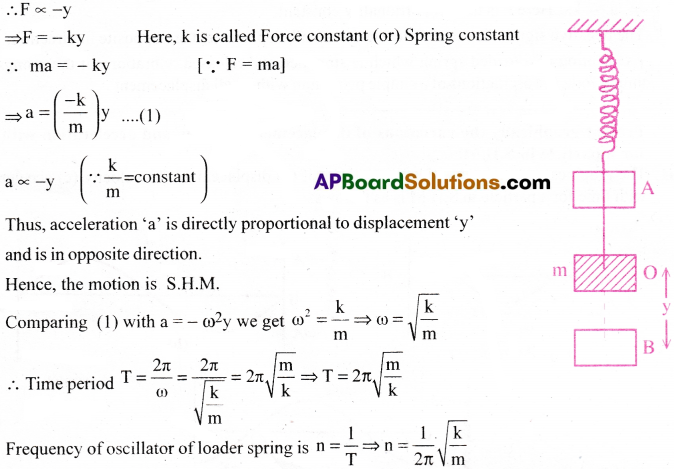
![]()
Question 5.
Derive expressions for the kinetic energy and potential energy of a simple harmonic oscillator.
Answer:
We know the displacement of a particle executing SHM is y = A sin ωt

Potential Energy :
Potential Energy of a simple harmonic oscillator is equal to the work done against the restoring force in producing the displacement ‘y’.
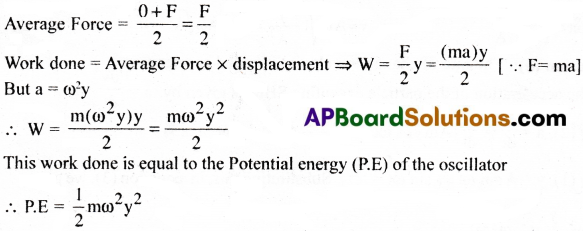
Question 6.
How does the energy of a simple pendulum vary as it moves from one extreme position to the other during its oscillations?
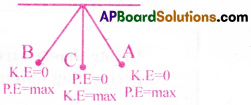
Answer:
At the extreme position, velocity of the simple pendulum (i.e., bob) will be zero. So its K.E will also be equal to zero. Its total energy will be in the form of P.E
When the bob comes towards mean position, its velocity gradually increases and becomes maximum at the mean position. So K.E also gradually increases and becomes maximum at the mean position. But its P.E decreases by the same amount so that T.E will be same at every point.
As the bob goes from mean position to another extreme position, its velocity gradually decreases and becomes zero at the extreme position. So K.E becomes zero. At this time P.E of the bob increases but T.E of the bob always remain constant.
Question 7.
Derive the expressions for displacement, velocity and acceleration of a particle executes S.H.M.
Answer:
Consider a particle P moving along the circumference of a circle of radius A in anticlockwise direction, with uniform angular speed ω.

Displacement (y) :
Let the particle be at X when time t = 0.
Let the particle be at P after time t.
. The angular displacement of the particle is θ = ωt.
When the particle moves from X to P, the projection moves from O to N.
The distance of ‘N’ from ‘O’ is called displacement y
from ∆ OPN, sin θ = \(\frac{ON}{OP}=\frac{y}{A}\) ; y = A sinθ;
y = A sin ωt ………. (1)
This is the equation for displacement of a particle in SHM.
Velocity (V) :
The rate of change of displacement is velocity.
Hence, the velocity of the particle executing SHM is given by, v = \(\frac{dy}{dt}\)
From (1), we have y = A sinωt ⇒ v = \(\frac{dy}{dt}=\frac{d}{dt}\)(A sin ωt) = (A cos ωt) ω
Acceleration (a): The rate of change in velocity is called acceleration.
∴ v = A ω cos ωt …………. (2)

Long Answer Questions
Question 1.
Define simple harmonic motion. Show that the motion of (point) projection of a particle performing uniform circular motion, on any diameter, is simple harmonic. [TS 15, 16, 18, 19; AP 16, 18, 19]
Answer:
Definition :
The ‘to and fro motion’ of a particle along a straight line, about a fixed point is said to be Simple Harmonic motion, when
(i) the acceleration is proportional to its displacement, in opposite direction.
(ii) acceleration is always towards the fixed point.
Proof :
Consider a particle P moving along the circumference of a circle of radius A in anticlockwise direction, with uniform angular velocity ω.
If the particle P completes one revolution then the projection PN makes one oscillation on the diameter.

Hence the motion is S.H.M.
Thus, the motion of N which is the projection of P on the diameter is S.H.M.
![]()
Question 2.
Show that the motion of a simple pendulum is simple harmonic and hence derive an equation for its time period. What is seconds pendulum? [Imp.Q][TS 18,20,22; AP, TS 15, 16, 17, 18, 19, 20, 22]
Answer:
Consider a simple pendulum of length ‘7’, mass ‘w’ suspended from a rigid support as shown in the figure.
Let the bob is making an angle ‘0’ with the vertical at an instant.
The weight (mg) can be resolved into two perpendicular components.
One component ’mgcosθ’ balances the tension.
The other component ‘mgsinθ’ provides Restoring force.

Restoring force F = -mg sinθ
We know F = nra
∴ ma = -mg sinθ
⇒ a = -g sinθ
When θ is very small, sinθ ≈ θ
∴ a= -g(θ)
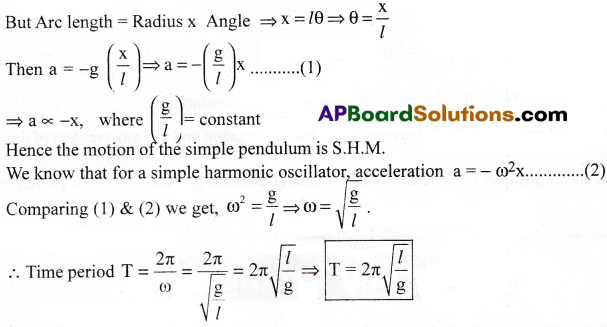
Seconds pendulum : A pendulum with time period 2 seconds is called seconds pendulum.
Question 3.
Derive the equation for the kinetic energy and potential energy of a simple harmonic oscillator and show that the total energy of a particle in simple harmonic motion is constant at any point on its path. [AP 19; Imp.Q]
Answer:
Kinetic Energy :
Consider a particle P moving along the circumference ofa circle of radius A, with uniform angular speed ω, at time t.
We know the displacement of the particle is y =A sin ωt
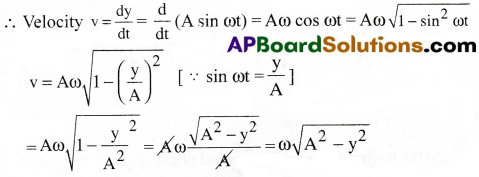

Potential Energy :
Potential Energy of a simple harmonic oscillator is equal to the workdone against the restoring force in producing the displacement ‘y’.
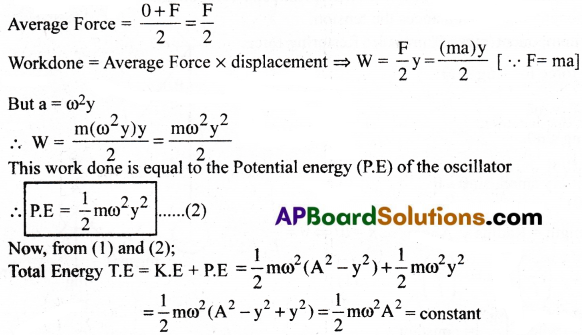
Thus, the total energy of simple harmonic oscillator is constant and it is independent of time and position.
Also, at mean position T.E = K.E[∵ P.E = 0] and at extreme position T.E = P.E [∵ K.E =0]
Solved Problems
Question 1.
On an average, a human heart is found to beat 75 times in a minute. Calculate its frequency and period. [AP 19; Imp. Q]
Solution:
The beat frequency of heart = 75/(1 min) = 75/(60s) = 1.25 s-1 = 1.25 Hz
The time period T = 1/(1.25 s-1) = 0.8 s.
Question 2.
Which of the following functions of time represent (a) simple harmonic motion and (b) periodic but not simple harmonic? Give the period for each case.
(a) sinωt – cosωt
(b) sin²ωt
Solution:

![]()
The function is periodic having a period T = π/ω. It also represents a harmonic motion with the point of equilibrium occurring at \(\frac{1}{2}\) instead of zero.
Question 3.
A body oscillates with SHM according to the equation (in SI units) x=5cos|27rt+7i/4| At t=I.5s, calculate the (a) displacement, (b) speed and (c) acceleration of the body.
Solution:
The angular frequency co of the body = 2πs-1 and its time period T = 1s.
At t = 1.5 s = \(\frac{3}{2}\) s
(a) Given displacement

Question 4.
What is the length of a simple pendulum, which ticks seconds? [AP 15, 16, 18; TS 15, 18]
Solution:

Exercise Problems
Question 1.
The bob of a pendulum is made of a hollow brass sphere. What happens to the time period of the pendulum, if the bob is filled with water completely? Why?
Solution:
When the hollow brass sphere is completely filled water, then there is no change in the effective length of the pendulum. So there is no change in its time period.
![]()
Question 2.
Two identical springs of force constant ‘k’ are joined one at the end of the other (in series). Find the effective force constant of the combination.
Solution:
Consider two springs of force constant ‘K’ each are connected in series as shown in the figure. When weight ‘mg’ is attached to the series combination, the restoring force ‘F’=mg in each spring will be the same. Since their force constants are same, the extensions produced in them are also same. Let y be the extension of each spring. Then total extension of the combination is 2y. In the case of a spring, we know that
restoring force = Force constant × displacement (taking only magnitude)
F = Force × constant 2y F
⇒ Force constant = \(\frac{F}{2y}\) ………. (1)
If a single spring of spring constant K is taken and the same weight mg is attached to it, then the restoring force in it is F = mg and extension produced is y. So F = \(\frac{F}{y}\) ………. (2)
comparing (l)and(2), force constant of series combination = \(\frac{K}{2}\)
Question 3.
What are the physical quantities having maximum value at the mean position in SHM?
Solution:
At the mean position, velocity and K.E. are maximum.
Question 4.
A particle executes SHM such that, the maximum velocity during the oscillation is numerically equal to half the maximum acceleration. What is the time period? [TS 15]
Solution:
If A is the amplitude and co is angular velocity of the particle in S.H.M.
then maximum velocity, vmax = Aω
and maximum acceleration, amax = Aω²

Question 5.
A mass of 2kg attached to a spring of force constant 260 NnH makes 100 oscillations. What is the time taken?
Solution:
Given mass attached to the spring, m = 2kg
Force constant of spring, K = 260 Nm-1
No. of oscillations completed = 100
Time taken to complete 100 oscillations (t) = ?
We know that, time period of a spring pendulum, T = 2π\(\sqrt{\frac{m}{k}}\).
⇒ T = 2π\(\sqrt{\frac{m}{k}}\) = 2 × 3.14 × 0.088 = 0.55 sec
∴ Time taken to complete 100 oscillations t = 100 × 0.55 = 55 sec
Question 6.
A simple pendulum in a stationary lift has time period T. What would be the effect on the time period when the lift (i) moves up with uniform velocity (ii) moves down with uniform velocity (iii) moves up with uniform acceleration a (iv) moves down with uniform acceleration ‘a’ (v) begins to fall freely under gravity?
Solution:
For a simple pendulum, then time period (T) is given by T = 2π\(\sqrt{\frac{l}{g}}\)
1) When the lift moves up with uniform velocity, there is no change in effective acceleration. So there is no change in time period.
2) When the lift moves downwards with uniform velocity, then also there is no change in effective acceleration. So there is no change in time period.
3) When the lift moves upwnwards with uniform acceleration a, then effective acceleration = g + a

Question 7.
A particle executing SHM has amplitude of 4cm, and its acceleration at a distance of lcm from the mean position is 3cms-2. What is its velocity when it is at a distance of 2cm from its mean position?
Solution:
Given amplitude (A) = 4cm
In S.FI.M., when the distance is x, then acceleration, a = ω²x (only magnitude)
Given a = 3cms-2 and x = 1cm

Question 8.
A simple harmonic oscillator has a time period of 2s. What will be the change in the phase 0.25 s after leaving the mean position?
Solution:
Given time period, T = 2sec
time interval, t = 0.25 sec
phase change = ?
We know that in a time period T, the change in phase = 2π rad
∴ in a time 0.25 sec, the change in phase = ?
i.e, for 2sec, phase change = 2π rad

Question 9.
A body describes simple harmonic motion with an amplitude of 5cm and a period of 0.2s. Find the acceleration and velocity of the body when the displacement is (a) 5cm (b) 3cm (c) 0 cm.
Solution:
Given amplitude (A) = 5cm = 5 × 10-2m
and time period (T) = 0.2sec
(a) when the displacement x= 5cm
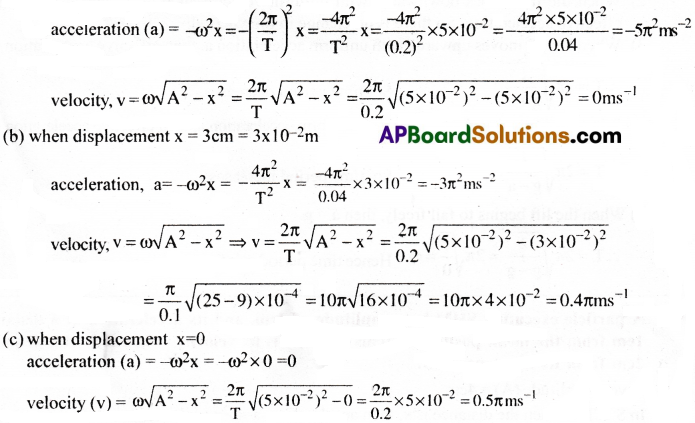
Question 10.
The mass and radius of a planet are double that of the earth. Sf the time period of a simple pendulum on the earth is T, find the time period on the planet. [AP 20]
Solution:
Let mass of earth = M and radius of earth = R
So mass of planet = 2M and radius of planet = 2R
Now, acceleration due to gravity on earth, ge = \(\frac{GM}{R^2}\)
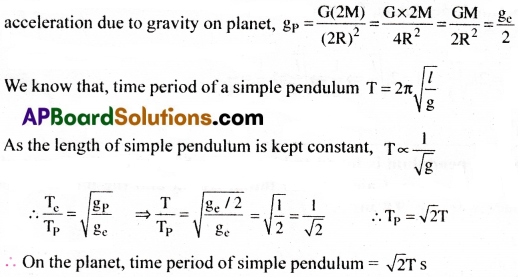
Question 11.
Calculate the change in the length of a simple pendulum of length im, when its period of oscillation changes from 2s to 1.5 s. [TS 18]
Solution:
Let initial length of pendulum, l1 = 1m
Initial time period T1 =2 s
Final time period T2 = 1.5 s
Let final length of pendulum = l2
change in length = l1 – l2 = ?
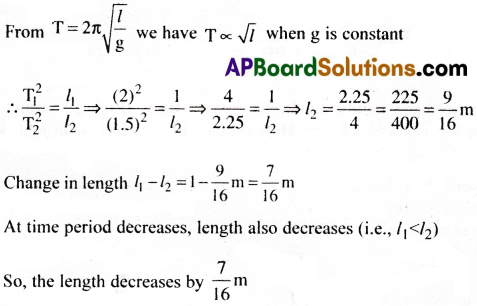
![]()
Question 12.
A freely falling body takes 2 seconds to reach the ground on a planet, when it is dropped from a height of 8m. If the period of a simple pendulum is n seconds on the planet, calculate the length of the pendulum.
Solution:
For a freely falling body, u = 0
time of fall t = 2s
height = distance travelled (h) = 8m
Let acceleration due to gravity on the planet (a) = g
From s = ut + \(\frac{1}{2}\)at² ⇒ 8 = 0 + \(\frac{1}{2}\)g × 4 ⇒ 8 = 2g ⇒ g = 4ms-2
Now, time period of simple pendulum, T = π s
length of pendulum, l =?

Question 13.
The period of a simple pendulum is found to increase by 50% when the length of the pendulum is increased by 0.6in. Calculate the initial length and the initial period of oscillation at a place where g = 9.8 ms-2.
Solution:
Let initial length = l
final length = (l + 0.6)m
Let initial time period = T
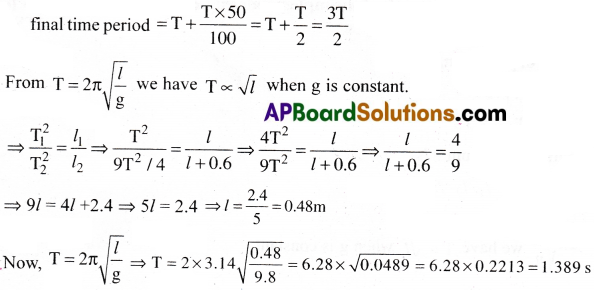
Question 14.
A clock regulated by a second’s pendulum keeps correct time. During summer the length of the pendulum increases to 1.02 m. How much will the clock gain or lose in one day?
Solution:
Time period of seconds pendulum, T1 = 2 s
Length of seconds pendulum l1 = lm
New length of pendulum in summer, l2 = 1.02 m
∴ New time period of pendulum, T2 =?

As length increased, time period increased. So it will take less number of oscillations. Hence the clock will go slow, (to complete one oscillation)
Error in time when it completes one oscillation = 2.02 – 2 = 0.02 s
A seconds pendulum makes \(\frac{86,400}{2}\) = 43,200 oscillations in one day.
∴ Error in time when it completes 43,200 oscillations = 43200 × 0.02 = 864 s
∴ The clock will go slow by 864 s per one day.
Question 15.
The time period of a body suspended from a spring is T. What wil! be the new time period if the spring is cut into two equal parts and the mass is suspended (i) from one part (ii) simultaneously from both the parts?
Solution:
Let the spring constant of spring be K and mass attached to the spring be m. Now time period
T = 2π\(\sqrt{\frac{m}{k}}\) ………… (1)
When the spring is cut into two equal pieces, the spring constant of each piece will be 2k. Since the same mass is attached
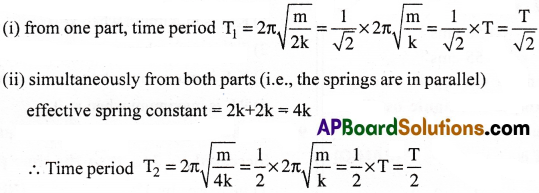
Multiple Choice Questions
Question 1.
The shape of l – T graph of simple pendulum is
1) Straightline
2) Parabola
3) Curve
4) Hyperbola
Answer:
2) Parabola
Question 2.
The maximum speed of a body vibrating with SHM with a period of π/4s and amplitude of 7 cm is
1) 488 cms-1
2) 56 cms-1
3) 38.5 cms-1
4) 55 cms-1
Answer:
2) 56 cms-1
Question 3.
Average potential energy in one time period of a simple harmonic oscillator whose amplitude is ‘A’ angular velocity oo and mass M is
1) \(\frac{1}{2}\)mω²A²
2) \(\frac{1}{4}\)mω²A²
3) mω²A²
4) 0
Answer:
2) \(\frac{1}{4}\)mω²A²
Question 4.
The restoring force acting on a particle executing SHM is
1) -ωx
2) mω²x
3) -mωx
4) -mω²x
Answer:
4) -mω²x
![]()
Question 5.
A simple pendulum hanging freely and at rest is vertical because in that position
1) K.E is zero
2) K.E is minimum
3) P.E is zero
4) P.E is minimum
Answer:
4) P.E is minimum
Question 6.
The length of the simple pendulum executing simple harmonic motion is increased by 21%. The percentage increase in time period of the pendulum of increased length is
1) 11%
2) 21%
3) 42%
4) 10.5%
Answer:
4) 10.5%
Question 7.
Time period of a simple pendulum is 2 sec. If its length is increased by 4 times, then its time period becomes
1) 8 sec
2) 12 sec
3) 16 sec
4) 4 sec
Answer:
4) 4 sec
Question 8.
A body executes simple harmonic motion. The potential energy (P.E), kinetic energy (K.E) and total energy (T.E) are measured as function of displacement ‘x’. Which of the following statement is true
1) K.E is maximum when x = 0
2) T.E is zero when x = 0
3) K.E is maximum when x is maximum
4) P.E is maximum when x = 0
Answer:
1) K.E is maximum when x = 0
Question 9.
If the length of a simple pendulum is increased by 2%, then the time period
1) increases by 1%
2) decreases by 1%
3) increases by 2%
4) decreases by 2%.
Answer:
1) increases by 1%
Question 10.
Average velocity of a particle executing SHM in one complete vibration is
1) zero
2) Aω/2
3) Aω
4) Aω²/2
Answer:
1) zero
Question 11.
A simple harmonic oscillator has an amplitude A and time period T. The time required by it to travel from x = A to x = A/2 is
1) T/6
2) T/4
3) T/3
4) T/2
Answer:
1) T/6
Question 12.
A particle executes linear simple harmonic motion with an amplitude of 3 cm. When the particle is at 2 cm from the mean position, the magnitude of its velocity is equal to that of its acceleration. Then its time period in seconds is

Answer:
2
Question 13.
The distance covered by a particle undergoing SHM in one time period is (amplitude = A)
1) zero
2) A
3) 2A
4) 4A
Answer:
4) 4A
Question 14.
Two simple harmonic motions of angular frequency 100 and 1000 rad s’1 have the same displacement amplitude. The ratio of their maximum acceleration is
1) 1 : 10³
2) 1 : 104
3) 1 : 10
4) 1 : 10²
Answer:
4) 1 : 10²
Question 15.
If a simple harmonic oscillator has got a displacement of 0.02 m and acceleration equal to 2.0 m/s² at any time, the angular frequency of the oscillator is equal to
1) 10 rad/s
2) 0.1 rad/s
3) 100 rad/s
4) 1 rad/s
Answer:
3) 100 rad/s
![]()
Question 16.
The total energy of particle performing SHM depends on
1) k, a, m
2) k, a
3) k, a, x
4) k, x
Answer:
2) k, a
Question 17.
In a simple harmonic motion, when the isplacement is one-half the amplitude, what fraction of the total energy is kinetic?
1) 1/2
2) 3/4
3) zero
4) 1/4
Answer:
2) 3/4
Question 18.
The potential energy of a simple harmonic oscillator when the particle is halfway to its end point is
1) 2/3 E
2) 1/8 E
3) 1/4 E
4) 1/2 E
Answer:
3) 1/4 E
Question 19.
Two springs of spring constant k1 and k2 are joined in series. The effective spring constant of the combination is given by
1) \(\sqrt{k_1k_2}\)
2) (k1 + k2)/2
3) k1 + k2
4) k1k2 /(k1 + k2)
Answer:
4) k1k2 /(k1 + k2)
Question 20.
A spring is stretched by 5 cm by a force 10 N. The time period of the oscillations when a mass of 2 kg is suspended by it is
1) 0.628 s
2) 0.0628 s
3) 6.28 s
4) 3.14 s
Answer:
1) 0.628 s
Question 21.
The time period of a mass suspended from a spring is T. If the spring is cut into four equal parts and the same mass is suspended from one of the parts, then the new time period will be
1) T/4
2) T
3) T/2
4) 2T
Answer:
3) T/2
Question 22.
The phase difference between displacement and acceleration of a particle in a simple harmonic motion is
1) π rad
2) 3π/2 rad
3) π/2 rad
4) zero
Answer:
1) π rad
Question 23.
A particle executing simple harmonic motion of amplitude 5 cm has maximum speed of 31.4 cm/s. The frequency of its oscillation is
1) 4 Hz
2) 3 Hz
3) 2 Hz
4) 1 Hz
Answer:
4) 1 Hz
Question 24.
A particle executes S.H.M. along x-axis. The force acting on it is given by
1) A cos (kx)
2) Ae-kx
3) Akx
4) -Akx
Answer:
4) -Akx
Question 25.
A particle executes simple harmonic oscillation with an amplitude a. The period of oscillation is T. The minimum time taken by the particle to travel half of the amplitude from the equilibrium position is
1) T/8
2) T/12
3) T/2
4) T/4
Answer:
2) T/12
Question 26.
The circular motion of a particle with constant speed is
1) periodic but not simple harmonic
2) simple harmonic but not periodic
3) period and simple harmonic
4) neither periodic nor simple harmonic
Answer:
1) periodic but not simple harmonic
![]()
Question 27.
Two SHM’s with same amplitude and time period, when acting together in perpendicular directions with a phase difference of π/2, give rise to
1) straight motion
2) elliptical motion
3) circular motion
4) none of these.
Answer:
3) circular motion